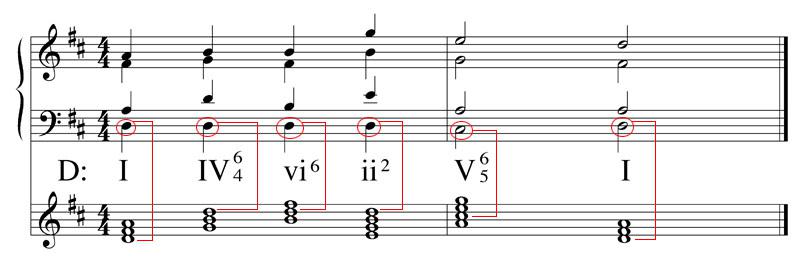26 Understanding Inversions of Triads and Seventh Chords
The use of the word inversion in music theory can have a number of different connotations. Within the context of tonal analysis, it indicates the configuration of chords with respect to the bass part. Tonal music relies on the inventiveness of the composer to create compelling voicings of each chord within a harmonic progression. Contributing to the choices that a composer must make in terms of voicing are the aesthetic desire for sonorities that possess strong resonance as well as a clear function within the progression. Especially important in arranging the chords is the motion of the bass, which provides much of the impulse behind the voice leading as applied to all of the parts. This is reason for the significance in determining what inversion a given chord is articulated.
1. Defining and Labeling Inversions. Chords are analyzed based on the quality and scale degree of a sonority within the context of the prevailing key center, which is notated in Roman numerals. The position of a sonority is based on the note of that chord that is articulated by the bass, which is notated in Arabic numerals to the right of the Roman.
Triads can have three positions:
- Root Position, with the root of the chord in the bass,
- 1st Inversion, with the third of the chord in the bass, or
- 2nd Inversion, with the fifth of the chord in the bass.
Seventh Chords can have four positions:
- Root Position, with the root of the chord in the bass,
- 1st Inversion, with the third of the chord in the bass,
- 2nd Inversion, with the fifth of the chord in the bass, or
- 3rd Inversion, with the seventh in the bass.
Note that the Arabic numerals represent the diatonic interval of each of the notes above the bass (in the most compressed possible version of the chord in the given position).

2. Shorthand Notation for Inversions. For the sake of an economical description of chord positions when analyzing scores, unique shorthand notations for the Arabic numerals have been developed. This enables one to, at a glance, be able to understand the function of a sonority, to know whether it is a triad or a seventh chord, and what note is in the bass.

3. Determining Inversions in Harmonic Analyses. To aid the student with analyzing a given score, it is advised to create a subsidiary staff below each system where one can write down all of the notes in each chord. Then, a simple procedure should be followed:
a) the first step is to collect the notes and arrange them into a series of thirds;
b) then notate the appropriate Roman numeral to describe what scale degree the triad is based on and its quality;
c) finally, given the bass part of each of the chords, notate the appropriate inversion with Arabic numerals.


